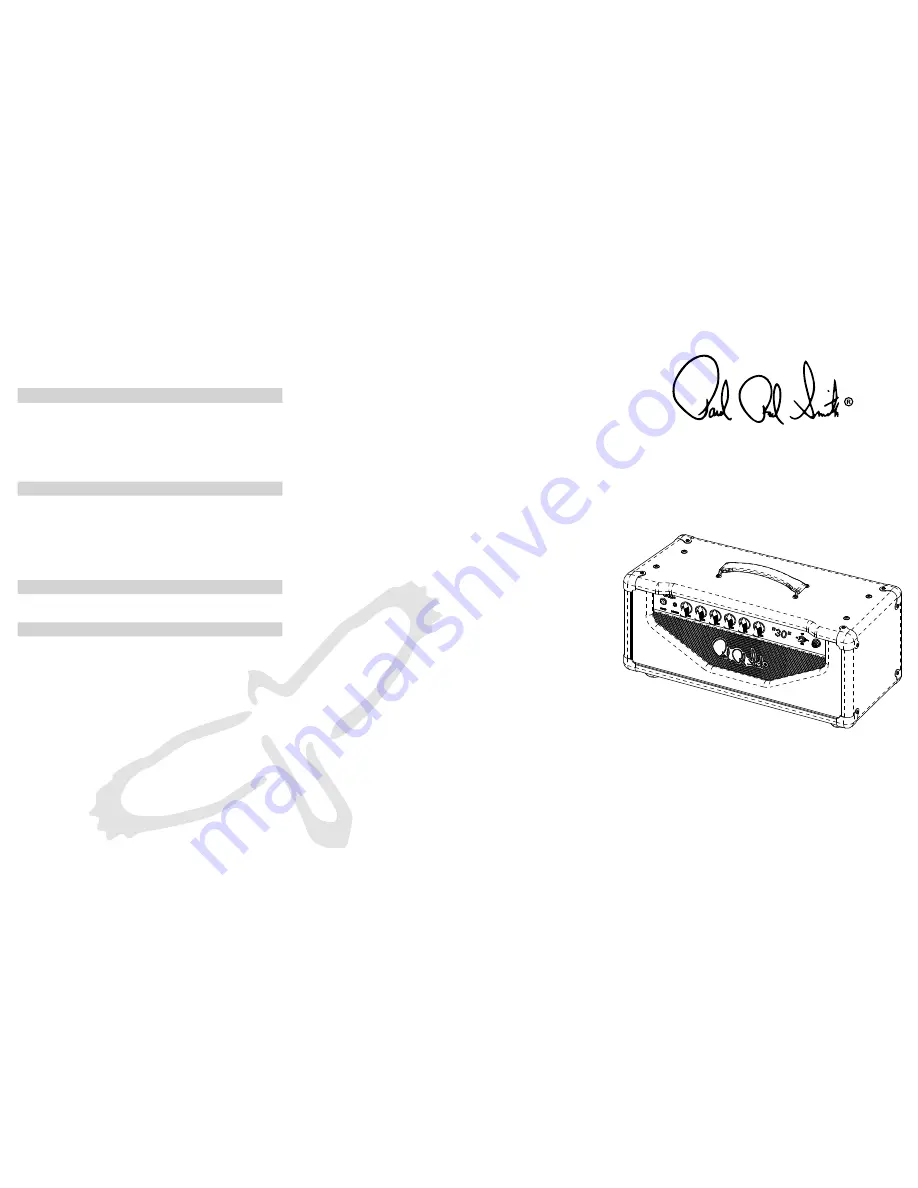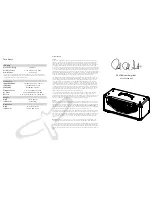
“30” Amp
Max Power Usage
200 Watts
Pre Amp Tubes
2 each 12AX7, 2 each 12AT7
Power Tube*
4 each EL84
* Power Tubes should be purchased as matched sets. Use only tubes in quads
that are factory-matched. Failure to use matched tubes can lead to tube failure
and amplifier damage or abnormal operation.
Main Fuses
100V 50Hz/60Hz
1.6A 250V Type 20mm x 5mm
120V 60Hz
1.6A 250V 20mm x 5mm
230V 50Hz
1A 250V 20mm x 5mm
Filament Fuses
2 each 6A 250V Type 3AG
B+ Fuses
2 each 500mA 440V Type 3AG
Reverb
3 Spring, Medium Decay, Tube Driven
Weight
Head
30 lbs (13.6kg)
1x12 Combo
42 lbs (19kg)
Dimensions
Head
24.5in X 12in X 12in
1x12 Combo
22.5in X 20in X 9.5in
PRS 30 Guitar Amplifier
User’s Manual
Tech Specs
Service Notes
Tubes
Tubes are consumables, as they have a given usable lifespan. They are part of the heart of
the tone, so keeping correctly operating tubes is essential. Tubes can fail catastrophically or
gradually, and it’s good to know what to look for if they start to go bad. Periodically inspect
them and look to see if anything inside the tube is glowing cherry red other than the normal
orange glow of the filament. This would indicate a situation where the tube is conducting
more current than it is capable of handling and most likely about to fail. Two other conditions
to observe are: 1) filaments not glowing or 2) a miniature fireworks display inside the tube. Any
of the above conditions indicate serious problems with the tube and should be taken care of
immediately. Tubes quite often are the cause of spurious noise in the amp. Microphonic tubes
will squeal or rattle with the vibrations of the cabinet. If suspected, tap each tube lightly with
a pencil with the amp powered up—the suspect tube will let you know. Note that there is a
normal metallic clinking when doing this, but a microphonic tube will be quite loud.
Instructions for Qualified Service Technician: To install the tubes, check that the power cord
is not plugged in, then remove the metal back panel with a screwdriver and notice the tube
sockets. Looking from the back, install the Power tubes (EL84s) in the left sockets. In each
case, align the pins correctly with the socket. The 12AX7 and 12AT7 preamp tubes can then
be placed in the 9-pin sockets to the right of the power tubes. Please refer to the tube chart
inside the amplifier for proper pre-amp tube locations. Be aware of the pin alignment with
these, as there is only one way they can fit. We utilize tube sockets that allow relative ease
of tube installation, but never force tubes into the sockets if there becomes a problem. Also,
never torque the tubes; only gently rock them from side to side during insertion or removal.
After tube installation, place the cylindrical spring tension preamp tube covers over the
preamp tubes and the spring retainers over the power tubes.
Since all the tubes in this model are self-biasing, replacing power and preamp tubes will
not require any adjustment under normal circumstances. However, after power tube
replacement, initially inspect the tubes often to assure there are no “cherry red” components
within the tube. Tubes today can have a wide variety of tolerances, and although very rare, if
the power tubes show any signs of over-current they should be replaced.
Fuses
There are 5 fuses installed in the amplifier. Only 1 of these, the main input fuse, is accessible
and replaceable by the user. There are 4 fuses internally for added safety. 2 of these fuses are
high voltage fuses, and 2 fuses are for the lower filament voltages. In all cases, labels indicate
the type and rating of the fuse. Replacement fuses MUST BE THE SAME TYPE AND RATING. If
they are not you can permanently damage your amplifier. Please contact your local PRS dealer
or the PRS accessories web site for information on ordering replacement fuses.
Instructions for Qualified Service Technician: Replacement of internal fuses requires removal
of the back panel and removal of the chassis. First, ensure the power cord is not plugged in,
then remove the back panel with a screwdriver. Loosen the 4 screws holding the chassis to the
top of the cabinet. Ensure the reverb cords are unplugged, then check that all components
are cool so that burns do not occur. Then, slide the chassis straight out of the back of the
cabinet.
NOTE!
Capacitors may retain an electric charge and can be dangerous even when the unit is
off, unplugged, and has not been played for an extended period of time. USE CAUTION!!!!
Locate the fuse holders and remove them, and check for continuity. Blown fuses can indicate
a failure condition and should be treated as though a problem exists. Check the label for the
proper type and rating. After all fuses have been replaced and the amp is tested as acceptable
and safe, reinstall the chassis by working in reverse. Be sure to plug the reverb cords back into
place.



















